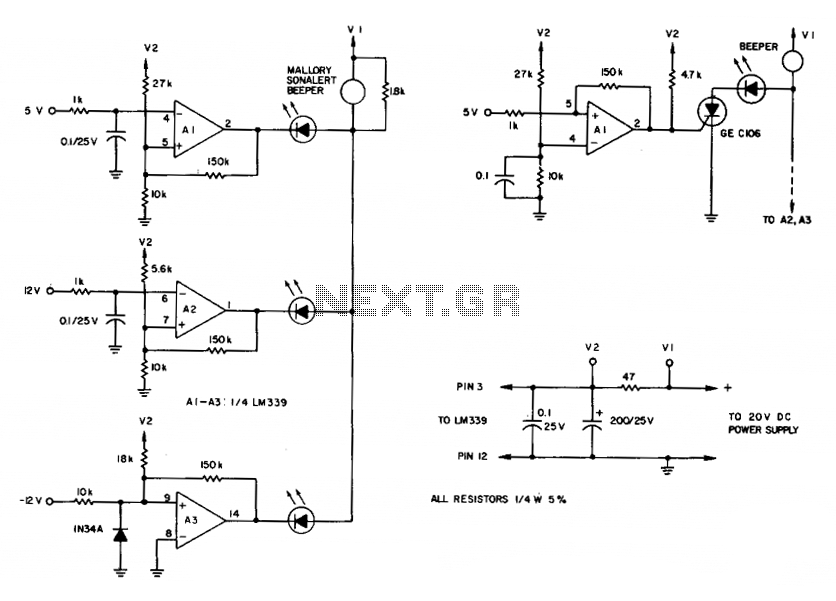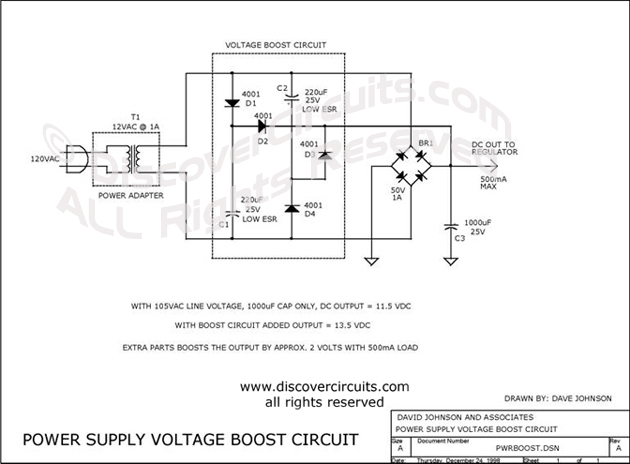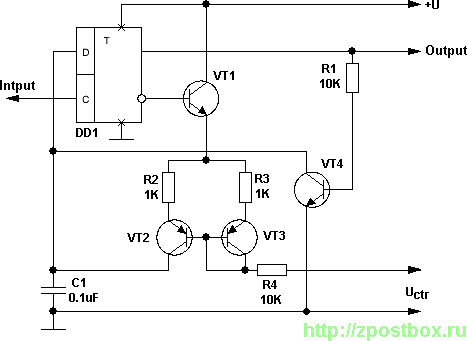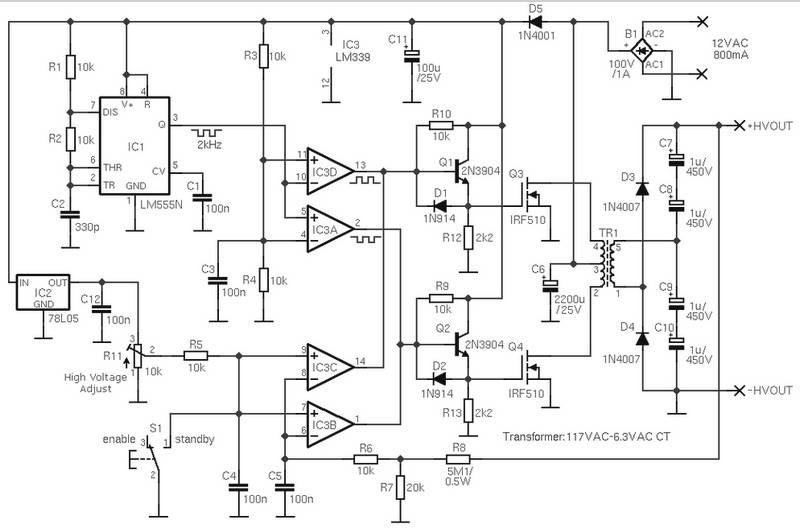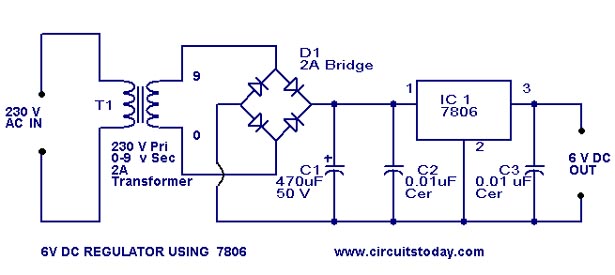
Voltage Controlled Voltage Source
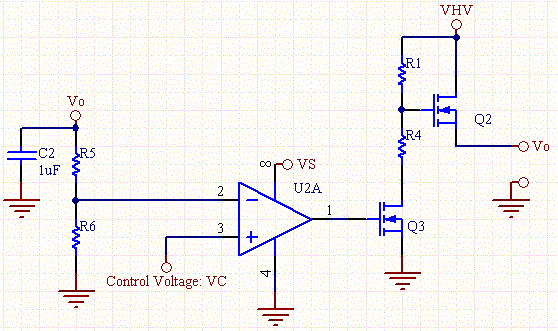
The drawback of the circuit mentioned is that the operational amplifier (op-amp) supply is connected to the high voltage (HV) supply. Most op-amps are limited to approximately 30V for their supply voltage, which prevents the circuit from functioning with higher output voltages. The circuit below addresses this issue by incorporating an n-channel MOSFET, which can be fully controlled within the op-amp's power supply range. The output voltage is directly proportional to the control voltage. Resistors R1 and R4 should be selected to ensure that the maximum gate-source voltage (Vgs(max)) of Q2 is not exceeded. Additionally, Q2 must have a drain-source saturation current (Idss) greater than VHV. The circuit depicted is a voltage-controlled voltage reference, with the output voltage directly proportional to the control voltage. It is important to note that the control voltage and feedback input of the op-amp are interchanged. A capacitor is used to prevent oscillation and should only be placed at the output. The circuit may oscillate if a capacitor is added across the feedback network, such as across R9.
This circuit design serves as a voltage-controlled voltage reference, effectively utilizing an n-channel MOSFET to regulate output voltage while maintaining the operational limits of the op-amp. The integration of the MOSFET allows for higher output voltage capabilities without exceeding the op-amp's voltage supply constraints. Selection of R1 and R4 is critical; these resistors must ensure that the gate-source voltage of the MOSFET does not exceed its maximum rating, which is essential for reliable operation.
The feedback mechanism of the op-amp is modified in this configuration, with the control voltage applied to the non-inverting input while the feedback input is routed to the inverting terminal. This arrangement allows for effective voltage regulation based on the applied control voltage. The feedback loop is designed to maintain stability, and the inclusion of a capacitor at the output serves to mitigate potential oscillations that may arise from feedback fluctuations. Care must be taken to avoid placing any capacitive elements across the feedback resistors, as this could lead to instability in the circuit.
Overall, this circuit provides a robust solution for applications requiring a stable voltage reference that can operate above the typical supply limits of standard op-amps, making it suitable for a variety of electronic design projects.The disadvantage of the circuit above is that the supply of the op-amp is tied to the HV supply. Most op-amps are limited to around 30V on the supply, so the circuit wont work for higher output voltages. The circuit below avoids this this problem by inserting a n-channel mosfet, which can be fully controlled within the range of the op-amps power s
upply. The output voltage is directly proportional to the control voltage. R1 and R4 should be chosen such that Vgs(max) of Q2 is never exceeded. Likewise Q2 should have an Idss greater than VHV. The circuit below is a voltage controlled voltage reference. The output voltage is directly proportional to the control voltage. Note that the control voltage and feed back input of the op-amp is swapped. The capacitor stops oscillation, and should only be placed on the output. The circuit will tend to oscillate if a capacitor is placed across the feedback network, for example across R9. Do you need help with an electronics design Daycounter provides contract electronics design services.
Contact us to give you a quote on your electronics design project. 🔗 External reference
This circuit design serves as a voltage-controlled voltage reference, effectively utilizing an n-channel MOSFET to regulate output voltage while maintaining the operational limits of the op-amp. The integration of the MOSFET allows for higher output voltage capabilities without exceeding the op-amp's voltage supply constraints. Selection of R1 and R4 is critical; these resistors must ensure that the gate-source voltage of the MOSFET does not exceed its maximum rating, which is essential for reliable operation.
The feedback mechanism of the op-amp is modified in this configuration, with the control voltage applied to the non-inverting input while the feedback input is routed to the inverting terminal. This arrangement allows for effective voltage regulation based on the applied control voltage. The feedback loop is designed to maintain stability, and the inclusion of a capacitor at the output serves to mitigate potential oscillations that may arise from feedback fluctuations. Care must be taken to avoid placing any capacitive elements across the feedback resistors, as this could lead to instability in the circuit.
Overall, this circuit provides a robust solution for applications requiring a stable voltage reference that can operate above the typical supply limits of standard op-amps, making it suitable for a variety of electronic design projects.The disadvantage of the circuit above is that the supply of the op-amp is tied to the HV supply. Most op-amps are limited to around 30V on the supply, so the circuit wont work for higher output voltages. The circuit below avoids this this problem by inserting a n-channel mosfet, which can be fully controlled within the range of the op-amps power s
upply. The output voltage is directly proportional to the control voltage. R1 and R4 should be chosen such that Vgs(max) of Q2 is never exceeded. Likewise Q2 should have an Idss greater than VHV. The circuit below is a voltage controlled voltage reference. The output voltage is directly proportional to the control voltage. Note that the control voltage and feed back input of the op-amp is swapped. The capacitor stops oscillation, and should only be placed on the output. The circuit will tend to oscillate if a capacitor is placed across the feedback network, for example across R9. Do you need help with an electronics design Daycounter provides contract electronics design services.
Contact us to give you a quote on your electronics design project. 🔗 External reference
Warning: include(partials/cookie-banner.php): Failed to open stream: Permission denied in /var/www/html/nextgr/view-circuit.php on line 713
Warning: include(): Failed opening 'partials/cookie-banner.php' for inclusion (include_path='.:/usr/share/php') in /var/www/html/nextgr/view-circuit.php on line 713
